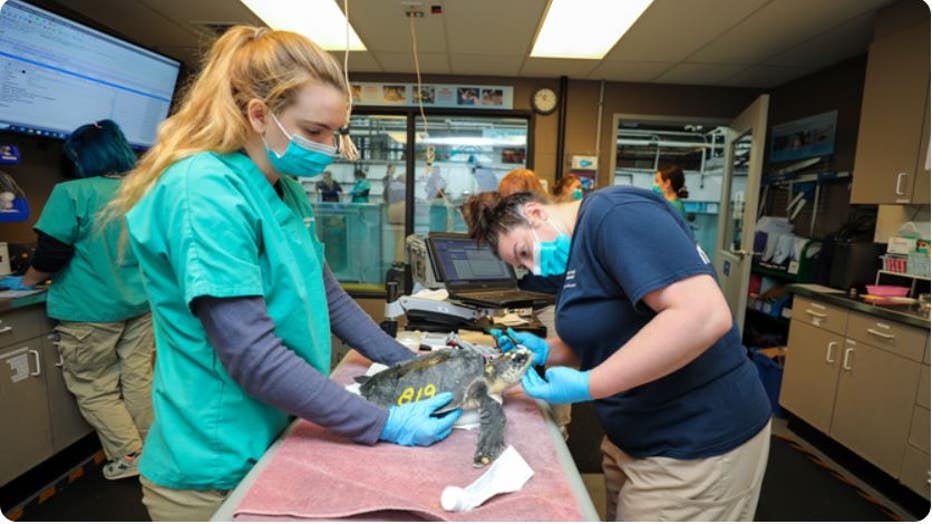Over 500 sea turtles rescued by Boston aquarium as cold-stunning season comes to a close
'Lasagna' is among the more than 60 sea turtles receiving long-term treatment at the New England Aquarium in Boston. (New England Aquarium)
BOSTON - The annual sea turtle stranding season will come to a close at the end of January, and workers at the New England Aquarium in Boston say they will continue to care for more than 60 turtles that are still too weak to survive on their own after being rescued from the frigid waters of Cape Cod Bay.
Turtles become cold-stunned when water temperatures drop below 50 degrees, and the cold-stunning season in New England usually occurs between November and January.
This year, the New England Aquarium’s Sea Turtle Hospital has cared for more than 500 live sea turtles that became stranded on Cape Cod.
And while many of those turtles were brought to other rehabilitation facilities to make room for more injured turtles, 64 of them will remain at the hospital to continue to undergo long-term treatment for life-threatening conditions, including pneumonia, sepsis, bone infections and dehydration.
"This is always an exciting time for us, focusing our efforts on turtles that will complete their full rehabilitation process here in Quincy," Adam Kennedy, Director of Rescue and Rehabilitation, said in a news release. "This is when we really get to know and understand the various medical conditions of the individual turtles receiving care at our Sea Turtle Hospital, a process that can take several months before these turtles can be released back into their ocean home."
WHAT ARE COLD-STUNNED SEA TURTLES?
What’s in a name?
Workers, volunteers and interns at the aquarium have a tradition of naming those turtles that will need long-term care.
This year is no different.
The aquarium announced that this year’s theme was pasta shapes, with Lasagna, Orzo and Fusilli among the names chosen.
COLD-STUNNED SEA TURTLE RELEASED INTO GULF OF MEXICO AFTER A YEAR OF REHABILITATION
Rescued turtles receive individualized care

A cold-stunned sea turtle gets examined by staff at the New England Aquarium in Boston. (New England Aquarium)
According to the aquarium, turtles like Udon and Orzo will receive an individualized treatment plan that includes medication, nebulization, laser therapy, and even acupuncture.
Most rescued turtles can be released back into the open waters south of Cape Cod during summer.
"Many of these turtles have chronic problems secondary to cold-stunning, which often require aggressive medical treatment. These plans are determined with a combination of physical exams, swim observations, bloodwork, X-rays, and potentially advanced diagnostics such as an MRI or exploratory surgery," Associate Veterinarian Dr. Melissa Joblon in the release. "At this point in the year, we are now able to provide more focused, individualized and intensive long-term care for our patients, and it’s very rewarding to see them improving over time."
SEAWORLD SUCCESSFULLY RETURNS 10 ENDANGERED SEA TURTLES BACK TO THE OCEAN
It's not only New England that sees cold-stunned sea turtles
While the water along the coast in the Northeast and New England gets extremely cold starting in the fall, those aren't the only locations where sea turtles can become cold-stunned.
In fact, cold-stunning events have been reported up and down the coast from Massachusetts and New York south along the Carolinas, Florida and Texas.
Before Christmas, an arctic blast of bitterly cold temperatures gripped most of the country. When that occurred, sea turtles became cold-stunned off the coast of Georgia.
The Georgia Sea Turtle Center, located on Jekyll Island in Glynn County, asked people to contact the center if they came across turtles that were in trouble because of the cold water temperatures.
At least six turtles were saved because of the cold snap.

